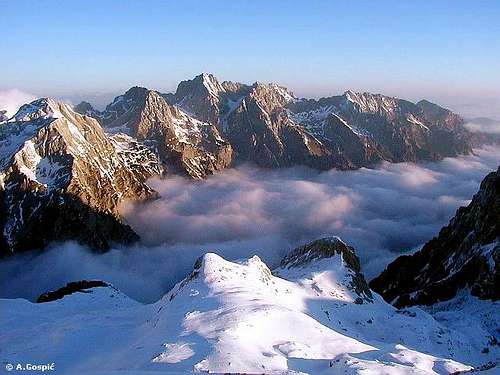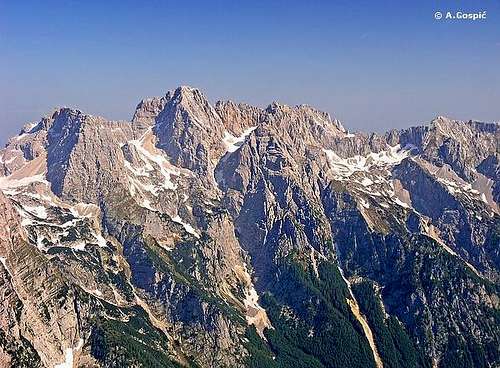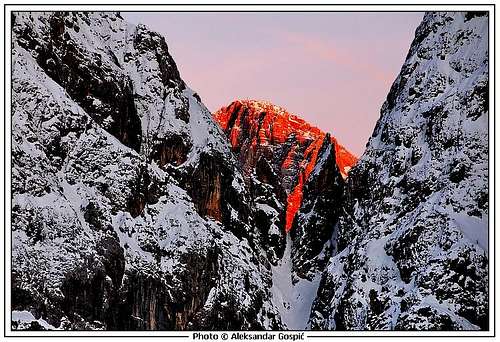|
|
Mountain/Rock |
|---|---|
|
|
46.43227°N / 13.82136°E |
|
|
8989 ft / 2740 m |
|
|
Intro
If Triglav is The King of the Julian Alps then Skrlatica is certainly his Queen. Wife of the King must be beautiful and powerful but still elegant with strong appearance. And Skrlatica is just like that, it impresses anyone who puts its sight on it. She is enchanting just like her King. Together they rule above the most beautiful Slovenian Alpine valley; Vrata valley.
Skrlatica (2740m) and its group
Skrlatica is second highest Slovenian peak and third highest in Julian Alps, behind Triglav (2864m) and Montaz (Iof di Montasio, 2754m). It is highest peak of Martuljek - Skrlatica group, which contains most of the wildest peaks in Julian Alps. Skrlatica, just like the whole group and Julian Alps in general, is very steep. Its sides fall deep into the valleys below with high faces and cliffs. On the northwest is Krnica valley, over 1600m lower. Above it Skrlatica shows it most powerful side, magnificent 700m NW face. Together with the faces of its southwestern neighbors; the nearby Rakova Spica (2545m) and Rogljica (2547m) it forms one of the most beautiful walls in Slovene mountains. Beside these two ridge peaks first real neighbor of Skrlatica in this direction is monumental Dolkova Spica (2591m). Between it, Rakova Spica, Rogljica and Skrlatica is large Zadnji Dolek (Last Basin) whose sides, below the cliffs of surrounding peaks, and bottom is strewn with scree and large boulders. On the southeast is Vrata valley, over 1700m lower. Towards it Skrlatica falls with around 600m high torn cliffs. From anywhere you look Skrlatica is fortress mountain and it reminds of Dolomite mountains. Closest neighbor on the northeast is wild Visoki Rokav (2646m) (High Rokav). Between them is wild and airy teethed ridge. Over it Skrlatica is connected to Martuljek group. On the east is Spodnji Rokav (2500m) (Lower Rokav). With these two Rokav’s Skrlatica closes wild V Kotlu (In the Cauldron) basin that is surrounded with these wild peaks and filled with scree. This is one of the wildest corners of Julian Alps.
Skrlatica group is placed between Martuljek group, on the north, with which is forms larger group, and Prisojnik (2547m) - Razor (2601m) group, on the south.
Most important peaks of the Skrlatica – Martuljek group are:
~ Visoki Rokav (2646m)
~ Visoki Oltar (2621m)
~ Visoka Ponca (2602m)
~ Dolkova Spica (2591m)
~ Dovski Kriz (2542m)
~ Siroka Pec (2497m)
~ Spik (2472m)
~ Skrnatarica (2448m)
~ Kukova Spica (2427m)
Beside Skrlatica only Dolkova Spica and Spik have been reached by marked (secured) paths. This group has least number of paths. All other peaks are reserved for climbers and alpinists, what makes this group their true preserved playground and most untouched area of Julian Alps.
On the first look Skrlatica does not have a week point but anyway a secured trail found its way to the summit, via southern ridge, which is above Vrata valley. If there wasn’t a trail to the summit, Skrlatica would be one of the, if not THE toughest Slovenian mountain. It resisted conquering for a long time. Many famous alpinists of 19th century tried and failed. Finally in 1880, famous explorer of Julian Alps, Dr. Julius Kugy and two guides from Trenta valley, Andrej Komac and Matija Kravanja, climbed it. Today’s path follows their footsteps. Even today Skrlatica is described as tough mountain, reserved for experienced mountaineers.
There are 3 different routes to climb Skrlatica, each ascending from a different valley. Vrata valley route is classic, used by most mountaineers. It is also shortest and easiest of 3. Krnica valley route is harder and includes two tough ferratta sections (secured paths with pegs and fixed steel ropes). First is Kriska Stena face and the other is summit climb. Trenta valley route is longest but less technical than Krnica valley route. They join on top of Kriska Stena face. Summit climb is the same for all routes as Krnica and Trenta valley routes meet Vrata valley route in Zadnji Dolek basin at the southern foot of Skrlatica.
View from Skrlatica is very wide and beautiful towards all sides. It matches the one from Triglav but in one aspect it is even better. From Skrlatica one can see something that is missing in Triglav panorama: the Father himself (as Slovenians call Triglav) and its monumental North face, which is from Skrlatica in full display.
Hike Advices
Most direct and classic Skrlatica approach is from Vrata valley. It can be done in a day but you can count on leg muscle inflammation for next two days because of 3.5km of altitude difference! This combination requires long day. You can make it easier if you split the climb in two days by reaching the Rusje bivouac on the first day (afternoon).
Same goes for Krnica valley route and it is even tougher, longer and has bigger altitude difference which is over 4km! This route is almost undoable in both ways in a day. You can split it in two by descending to Rusje bivouac after the summit and tomorrow descent back to Krnica.
If it sounded tough for previous 2 routes Trenta valley route is even tougher than Krnica and has even bigger altitude difference. One has to be really crazy to do this route both ways in a day and it is impossible to complete it during the daylight but night descent from Pogacnikov Dok hut to Trenta valley is not a problem. Because of the position of Pogacnikov Dom hut it is not even easy to split this route in two days and have two easier days. When doing Trenta route it is best to do it in 3 days and combine with some of the nearby peaks like Razor (2601m), Planja (2447m), Pihavec (2414m), Kriz (2410) and Stenar (2501m).
Here is very beautiful two day combination from Vrata valley. On the first day (morning start) reach Pogacnikov Dom via Sovatna. In the afternoon climb Razor and sleep over. On the second day head towards Skrlatica via Dolkova Spica, which you will climb on the way because its summit is close above Rdeca Skrbina pass. From the summit of Skrlatica descent to Vrata valley via classic route.
Here is beautiful three day combination from Trenta valley. On the first day (morning start) reach Pogacnikov Dom. In the afternoon climb Razor and sleep over. On the second day head towards Skrlatica via Dolkova Spica, which you will climb on the way because its summit is close above Rdeca Skrbina pass. From the summit of Skrlatica return to Pogacnikov Dom via Rusje Bivouac and sleep over. On the third day, before descending back, climb nearby Pihavec or Stenar. Or even better, head via Luknja pass towards Triglav and extend your trip.
When To Climb
Best period to climb Skrlatica, if you don't like snow and extreme climbs, is from July to October. In June it is not cold anymore but there can be quite a lot of steep snow fields on the routes, which of course is not a problem for equipped mountaineer. Most beautiful time to visit in main season is October when golden larches shine on the slopes of Julian Alps, especially in second half of October. Also air is cleanest in October when comparing with other main season months.
Outside that period it is cold with lot of snow. Best route is from Vrata valley (Aljazev Dom hut) because it's least technical and shortest. Up to summit climb are non techical, but steep snowy slopes. Summit climb pegs and fixed ropes are under snow, which turns Skrlatica in unreachable ice fortress reserved only for experienced alpine climbers, which know to deal with such technical problems (up to IV grade).
Pogacnikov Dom hut route is also not technical till summit climb but is too long for short winter days. If you want to do it split climb in two days by sleeping in huts winter room.
Krnica valley route is only for experts in winter because of almost perpendicular, 300m high, ferratta section surmounting Kriska Stena face.
Snow is possible even in summer but it won’t remain on ground before October. In summer significant is daily cloud development. From my experience and observations, Skrlatica is peak, which spends more time in the clouds than any other peak in Julian Alps.
Mountain Conditions
Mountain conditions in Julian Alps are well known thanks to Kredarica (2515m) hut and meteo station, which is just below the Triglav (2864), highest peak of Julian Alps. Because Mojstrovka is some 200m lower than Kredarica temps are few degrees higher.
Best overview of daily data values is provided by Russian Weather Server -> Kredarica @ Infospace.ru
You can also observe current conditions and forecast for Kredarica on the Wunderground meteo site.
Wunderground - Kredarica page.
Current weather and forecasts can also be found on the Slovenian Environment Agency pages.
Direct link to Current Conditions page
Direct link to Snow Depth page
Getting There
3 routes from 3 different valleys mean 3 different trailheads. How to reach them is described in each route section.
The heart of the region is Kranjska Gora resort town, 84 kilometers from the Slovenian capital Ljubljana. Mojstrana village, 13km before Kranjska Gora, when coming from Ljubljana, is center to visit Vrata valley.
By Plane
If you want to reach Ljubljana, Slovenian capital, by plane check a timetable on the site of Adria Airways, a national airline.
By Bus
From Ljubljana buses depart towards Mojstrana and Kranjska Gora every 60 minutes. During the season and when there is no snow buses connect Kranjska Gora with Bovec town. This line goes over the Vrsic pass and into the Trenta valley which takes you to Trenta valley trailhead.
By Train
In Mojstrana and Kranjska Gora direction, train will take you to Jesenice town, 10km before Mojstrana where you would have to wait for the bus from Ljubljana. Jesenice are on the main railway from Ljubljana towards Austria and Germany so it can be reached by train from Western Europe. See schedules on the sites of Slovenian railways and German railways.
By Car
From Ljubljana via the highway towards Karavanke tunnel and via the road it is 71km to Mojstrana and 84km to Kranjska Gora.
From central Europe approach leads through Villach, Austria: via Karavanke tunnel (around 40km) or Korensko Sedlo pass (around 30km).
From western Europe approach leads through Udine, Italy: exit from Udine – Villach highway in Tarvisio. From Tarvisio to Kranjska Gora is another 20km.
Huts Along the Routes

Aljazev Dom (1015m) (Aljaz Hut) is placed in upper part of Vrata valley, near the forest end. It is accessible by car, 12km from Mojstrana village, which lies on the main road from Ljubljana (72km) to Kranjska Gora resort (12km). It was opened in 1896. In 1909 the hut was destroyed by avalanche. New hut was opened the next year where it stands today. It has 150 beds and is open from beginning of May till the end of October. Winter room has 8 beds. Hut also has phone, electricity, warm water and so on. From the hut view is beautiful on the peaks around the valley, which rise wildly above it, and especially on Triglav and its North face.
Pogacnikov Dom na Kriskih Podih (2050m) (Pogacnikov Dom hut on Kriski Podi) is standing on the edge of Kriski Podi basin, high above the Trenta valley and is ‘home’ hut for Razor. Kriski Podi are bare rock basin, which is ascending in few steps. At the foothills of those steps lie 3 beautiful alpine lakes: lower, middle and upper Krisko jezero lakes. Area is surrounded from 3 sides by peak. Highest of them is Razor (2601m). The hut was opened in 1951 and named after a Joze Pogacnik whose idea was to build a hut here. Unfortunately he died on the way from Trenta valley to hut opening ceremony. In 1985, near the hut, load aerial ropeway and winter room were built. The hut is open from July 1st till the end of September. It has 67 beds + 16 in winter room, water and electricity from a generator. View from the hut is beautiful towards Trenta valley and Soca River, which shines on the afternoon sun and the wild peaks around.
Koca v Krnici (1113m) (Hut in krnica) stands on a small meadow in conifer forest on the bottom of Krnica valley. The valley is surrounded by high peaks: Skrlatica (2740m), Razor (2601m) and Prisojnik (2547m). Opening year was 1933. It is open from May 1st till October 31st, while outside that frame during weekends and holidays. It has 20 beds, water and power from a generator.
Bivak IV na Rusju (1980m) (Bivouac IV on Rusje) stands high above Vrata valley, on the slopes below Dolkova Spica (2591m) and Stenar (2501m), since 1948. During the 1950/51 winter it was blown away in the storm and ended up some 80 meters away. In 1953 a new one has been built. It is constantly open and has 10 sleeping places, furnace and water reservoir.
Camping
Camping inside the National Park is forbidden. Beside the mountain huts there are plenty of hotels and private apartments in the towns and villages, which surround the area. Here are few links where you can find info on accommodations closer and further away:
Kranjska Gora
Mojstrana
Bled
Bohinj
Bovec
Red Tape
Skrlatica and its surroundings is in the Triglav National Park but there is no entrance fee. The only thing charged is parking on selected locations.




































Vid Pogachnik - Jun 6, 2006 9:24 pm - Voted 10/10
Skiing from Skrlaticahere is an interesting note about possible skiing from the summit of Skrlatica: Two well known Slovenian climbers, Marijana Cuderman & Marko Kern (see their famous page: Marijana & Marko) did on May 7th, 2006 this interesting route: From Vrata valley they ascended Skrlatica by the normal route (foggy, lousy weather), then they skied down from the summit into V Kotlu basin (45 degrees, IV, exposed in the upper part), crossed the basin, climbed on the notch between Visoki and Srednji Rokav, and finally skied down the couloir from the notch (45 degrees, III+, 200m) and further all the way into Vrata valley. Great tour!